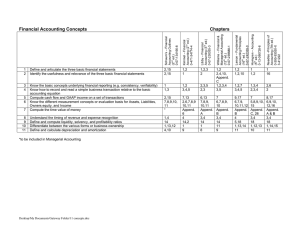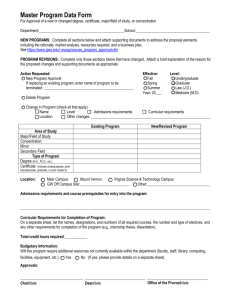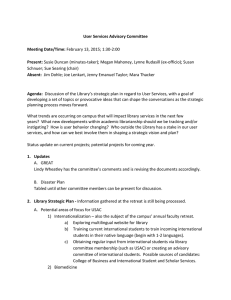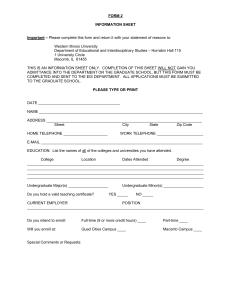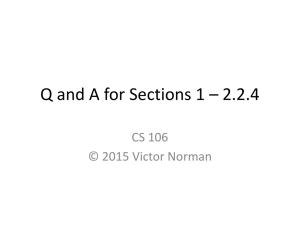APPENDIX B Undergraduate Program Proposal Submission Packet and Proposal Format
advertisement
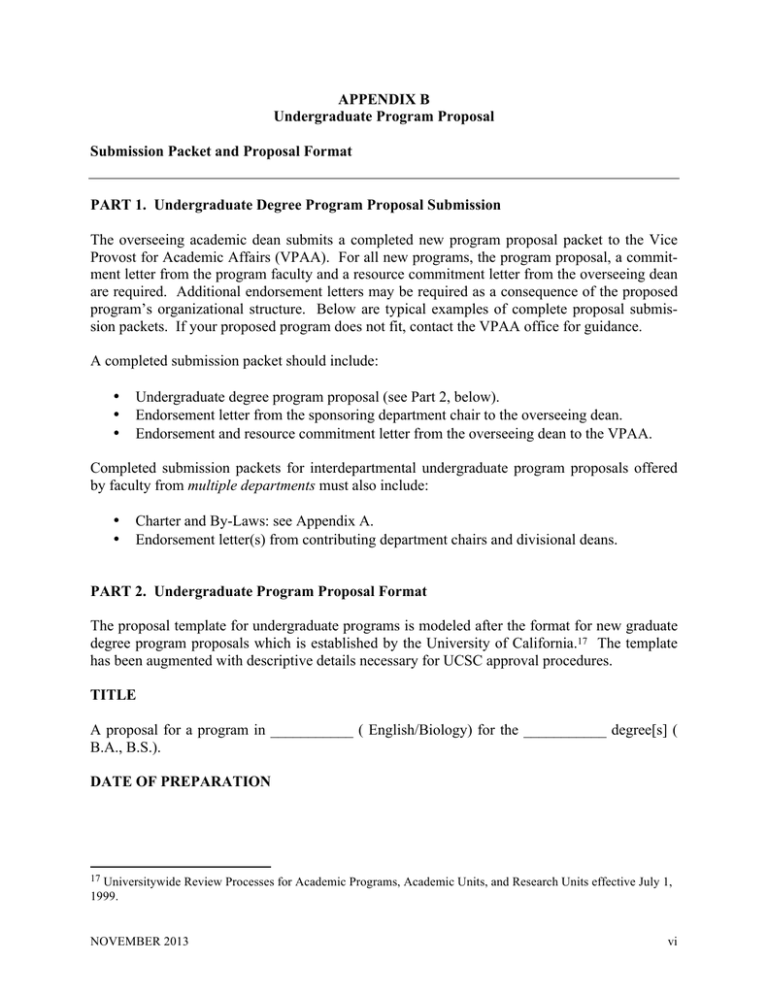
APPENDIX B Undergraduate Program Proposal Submission Packet and Proposal Format PART 1. Undergraduate Degree Program Proposal Submission The overseeing academic dean submits a completed new program proposal packet to the Vice Provost for Academic Affairs (VPAA). For all new programs, the program proposal, a commitment letter from the program faculty and a resource commitment letter from the overseeing dean are required. Additional endorsement letters may be required as a consequence of the proposed program’s organizational structure. Below are typical examples of complete proposal submission packets. If your proposed program does not fit, contact the VPAA office for guidance. A completed submission packet should include: Undergraduate degree program proposal (see Part 2, below). Endorsement letter from the sponsoring department chair to the overseeing dean. Endorsement and resource commitment letter from the overseeing dean to the VPAA. Completed submission packets for interdepartmental undergraduate program proposals offered by faculty from multiple departments must also include: Charter and By-Laws: see Appendix A. Endorsement letter(s) from contributing department chairs and divisional deans. PART 2. Undergraduate Program Proposal Format The proposal template for undergraduate programs is modeled after the format for new graduate degree program proposals which is established by the University of California.17 The template has been augmented with descriptive details necessary for UCSC approval procedures. TITLE A proposal for a program in ___________ ( English/Biology) for the ___________ degree[s] ( B.A., B.S.). DATE OF PREPARATION 17 Universitywide Review Processes for Academic Programs, Academic Units, and Research Units effective July 1, 1999. NOVEMBER 2013 vi SECTION 1. INTRODUCTION A statement setting forth the following: 1. Purpose and objectives of the program. Describe distinctive features, including pedagogical underpinings. Articulate program learning outcomes, student competencies that are achieved in the program. 2. The timetable for development of the program and enrollment projections. Specify the timing for: a) Program Approval. b) New faculty hires. c) Course approvals. d) First availability of core offerings. e) Preparation/availability of catalog copy. f) Availability of space/facilities needed for program. g) Coordination of outreach efforts. h) Development of articulation agreements with community colleges. i) Admission year for first cohort of frosh. j) Admission year for first cohort of junior transfers. k) Anticipated year of awarding first degrees. 3. Consistency of enrollment projections with the campus enrollment plan. State if any other programs may have their enrollments reduced in order to accommodate the proposed program. 4. Relationship of the proposed program to existing campus programs and current campus academic plans. a) If the program is not in the campus academic plan, why is it important that it be begun now? State evidence of high campus priority. b) Could the curriculum be offered just as effectively within an existing structure (e.g. as a pathway within an existing major program)? c) What overlaps exist between the proposed curriculum and the curricula of other units on this campus? d) Effect of the proposed program on other programs offered by the sponsoring departments. 5. How does the program fit with other programs in the University of California and/or regional public or private institutions?. a) Discuss the possibility of cooperation or competition with other programs within the university. b) Differences from other similar programs within the University and other California institutions. NOVEMBER 2013 vii 6. Student demand. a) Provide statistical evidence of student demand, such as enrollment trends, admissions trends, student inquiries, or course enrollments in related majors. b) Provide evidence supporting the view that this demand will be stable and long lasting. c) Graduate career placement opportunities; cite employment prospect data and literature where possible. Append relevant statistics and clippings. 7. Program Evaluation. Program reviews will occur according to established campus review guidelines and consolidated with the sponsoring department’s review. Interdepartmental undergraduate program reviews will be consolidated with the administrative home department’s review. State which departmental review will include the proposed program. SECTION 2. CURRICULUM 1. List all present and proposed courses and their instructors. Distinguish clearly between existing and new course offerings, required courses and electives. a) Indicate when newly proposed courses will become available. b) Define the schedule on which all courses will be offered (e.g. annually, every quarter, semi-annually etc.). c) Include courses offered in related fields. d) Append the catalog description of all required and recommended courses. e) Discuss the relationship of these courses to specific fields of emphasis. f) Describe the course offering structure, how do they build on each other? 2. Curriculum Plan. Describe how the new course load will be distributed among existing faculty and future hires for three years taking account existing course loads and projected ladder faculty leaves and absences. 3. Program Learning Outcomes: a) A multiyear plan for assessing effectiveness of instruction of learning outcomes noted in Section 1, part 1. b) A curriculum alignment matrix showing how the curriculum supports the learning outcomes and where they are assessed. 4. Student Program of study: a) Specific fields of emphasis. b) Unit requirements. c) Required and recommended courses - if multiple pathways offered, provide separate description for each. d) Student Study Plan for four years (demonstrating students can complete degree in normative time). e) General education and college requirements – how do they integrate with the program? f) Explanation of any special requirements or enhancements. (e.g. Education Abroad, internships, etc.) 5. Graduation requirements, including comprehensive exit requirements. NOVEMBER 2013 viii 6. Major Admission Requirements. a) Describe high school and transfer student preparation recommended or required including courses, foreign language, or test requirements. b) Are necessary course articulation agreements in place with community colleges? c) Describe any specialized pre-requisities for acceptance to the major. (field examinations, portfolio reviews, etc.) d) What assurances are there that specialized admission requirements will not put any student group at a disadvantage? SECTION 3. FACULTY 1) Describe program faculty, include immediately pending appointments, and projected future hires. Briefly describe the relationship of the program to faculty research and professional interests. 2) List program faculty, core faculty first and then affiliated faculty. 3) Solicit and append comments from chairs of departments with programs and/or faculty closely related to or affected by the proposed program. 4) For participating faculty outside of the sponsoring department, append copies of letters indicating their interest and commitment to the program. 5) Append bylaws (Appendix A) if the proposal is for an interdepartmental program. SECTION 4. RESOURCE REQUIREMENTS 1. If applicable, state that no new resources will be required and describe how the program will be funded. 2. If new resources are required, estimate for the first 3 years the additional cost of the program, by year, for each of the following categories: a) FTE faculty. b) Library acquisitions (consult with librarians). c) Computing costs. d) Equipment (append inventory of current equipment and future needs). e) Space and other capital facilities. (append inventory of current facilities and future requirements) f) Other operating costs (supplies and expense, maintenance of labs and other facilities). g) Teaching Assistants. h) Technical and administrative/advising staff. (append description of current staffing level and future requirements) 3. Indicate the intended sources of funding for all new costs. a) If program is to be funded by internal reallocation, explain how internal resources will be generated and/or realigned and the effects of reallocation on existing programs. b) Clearly separate out any unmet needs. c) Describe opportunities/activities for securing external support. d) What resources (soft funding for instructors and staff, space, etc.) are indispensable to the operation of the proposed program; clearly separate basic requirements from long-term desires. NOVEMBER 2013 ix e) For the program’s first five years, describe the schedule on which these resources need to become available. f) Relate phasing of funding to targets for enrollments, majors, degrees, or other measures of workload accountability. SECTION 5. PROGRAM ADMINISTRATION Describe how the program will be administered so as to assure its long-term stability and coherence. Include: 1. Department or faculty group which will administer the program. 2. Administrative home for purposes of student major advising. 3. Specific provisions for program faculty oversight, including chair succession, student advising, and other leadership responsibilities. 4. Append agreements assuring that any courses and other faculty effort essential to the program will be available to guarantee any current cohort of students the opportunity for timely major completion. 5. Append a signed charter (Appendix A) if the proposal is sponsored by program faculty from multiple departments and/or divisions. SECTION 6. CHANGES IN SENATE REGULATIONS AND WASC APPROVAL The proposal should state clearly whether or not any changes in Senate Regulations at the Divisional level or in the Academic Assembly would be required. If changes are necessary (e.g., for all proposals for new degree titles), the complete text of the proposed amendments or new regulations should be provided. The Western Association of Schools and Colleges (WASC) is the accrediting agency for the University of California. New degree titles or new programs that involve instructional activities at off-campus locations or use distance-learning technologies may require prior approval from WASC. WASC substantial change requirements are posted at: http://www.wascweb.org/senior/subchange.html. Please contact Meg Lehr (mlehr@ucsc.edu) for questions concerning this. NOVEMBER 2013 x
